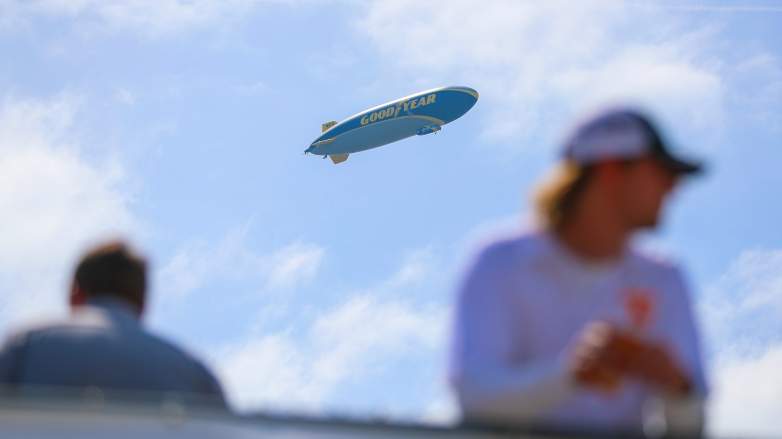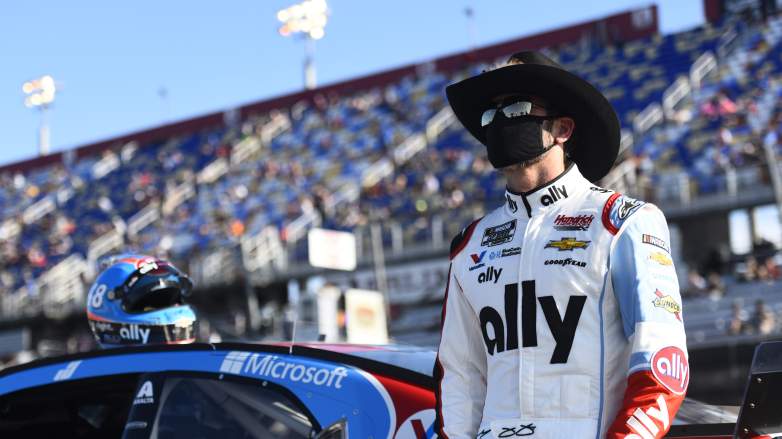
There are multiple factors that go into making a strong NASCAR broadcast. The talent in the booth and the people behind the scenes play a massive role. Equally important are the technological advancements that create safer conditions and drive changes off the track.
Heavy spent two race weekends shadowing FOX Sports and getting a behind-the-scenes look at the work that goes into bringing races to viewers at home. Part one focused on the people in charge of the video feeds and the storylines. Part two focuses on the technology at their fingertips.
The cameras are a fitting example. No longer are there camera operators spread out around the track potentially sitting in harm’s way in the event of a massive wreck that takes out the catch fence.
These operators are now safely situated inside one of the semi-truck trailers inside the FOX Sports/NBC Sports compound. Technology has advanced to a point where they can operate the cameras remotely with control arms attached to a shelf. The operators move these, which relay the instructions to the cameras situated around the various tracks.
“The robotic portion of it has evolved over the years,” explained George Grill, Coordinating Technical Producer. “It started many years ago but has come a long way in the past 10 years from when it first evolved to now. We’re able to control the kind of cameras that we’re able to put on the wall.
“In the early days, they were still pretty clunky. You were taking a standard camera and putting it on some kind of robotic mount. Now, it’s more specific to what you’re doing. It’s more compact, less in harm’s way even for the track itself.
“If a car was to go up and take it out, it’s made to break away. A lot smaller than it was years ago. So it has come a long way in the years. Technically, we’re able to now do 1080p HDR straight off the camera heads. Years ago, you would have had to up-convert that.”
The Personnel Changes Depending on Tracks

GettyRyan Blaney (center) talks during the FOX pre-race show.
The technology made it possible for FOX Sports to get its camera operators out of harm’s way, and it put them in a trailer where they have access to more predictable temperatures. Though this doesn’t mean that the job necessarily became easier.
In order to keep the viewers in tune with the action, the operators have to quickly move between the different control arms. They are constantly switching back and forth depending on where the prominent cars are on the track.
Interestingly, the number of operators depends on the style of track where NASCAR is competing each week. Superspeedways require fewer because the entire field is in one big pack. There are fewer stragglers to track throughout the race.
Short tracks, for comparison, require more personnel. There is constant action taking place at Martinsville Speedway, Bristol Motor Speedway, Richmond Raceway, and now North Wilkesboro Speedway, which means there is less time for the team members to react.
“If you think about it, a Talladega runs more in a pack,” Grill added. “It’s a big, 2.66-mile track, so the cars – even though they may be in Turns 3 and 4, there’s nothing in 1 or 2. So the guy who’s running the camera in [Turns] 1 and 2 can really run the camera in 3 and 4 and then move because they’re all right there next to each other.
“You get a place like Martinsville, even Charlotte, once they spread out, you don’t have that luxury. Because there’s always something in your view that you could be tracking. So there’s certain tracks you’ll need maybe a fourth operator for six cameras.
“You don’t necessarily need one per every camera because some of them are literally locked off cameras. They’re looking… what we’d call a speed shot. You’re looking for the feel of the race.”
These locked cameras sit in multiple spots and they provide different viewpoints throughout the race. Some are “tail away” shots that show the back of the pack as it moves past at nearly 200 mph. Others focus on the areas where cars have hit the wall and left marks, which show the level of difficulty involved in being a professional driver in NASCAR.
“There was a gate at Talladega,” Grill added. “We put a camera under, and it’s a fixed-look camera. But you just see the cars go doo, doo, doo, doo, doo, doo flying by you and it gives you that feel because you’re not there. It’s trying to bring you into it as much as possible.”
Each Piece of Technology Has a Purpose

GettyThe Goodyear Blimp hovers over Darlington Raceway.
In terms of cameras, there are more than just those situated around the track. There are some on the roof, some attached to the helmets of specific drivers, some on the cars, and others on aerial vehicles. They each have a purpose, which FOX Sports must determine throughout the NASCAR season.
Will this fixed-wing aircraft be best suited for Bristol Motor Speedway because of the size of the track? Will this helicopter be a better option at Circuit of the Americas or Sonoma Raceway due to the twists and turns? What about the drones?
“I grew up a race fan. I was a race fan before I was ever in TV,” Grill said. “So I used to go to races all the time. I followed NASCAR, I did all this before I ever got into NASCAR. Watched tons and tons of races as a fan.
“So that kind of gives me a little bit of perspective. I know where the cars run, where the action usually happens, where it’s happened in the past. Where is it likely to happen? So that’s the kinds of things we look at when we look for the drone.
“The drone is your extra feeling of the race. It’s not just coverage. It’s trying to get more of the feel for the race, the drone flying with [the car]. The sense of speed, rather than something just passing through your frame.”
FOX Sports Had To Quickly Adapt in 2020

GettyThe 2020 season had a major disruption.
Working with robotic cameras and drones was something that had been in progress for several years before the technology reached a point where it became truly seamless. FOX Sports had time to work on this while covering a wide variety of sports over the years.
In 2020, however, there were some major changes that had to take place due to something entirely out of the company’s control. The uncertainty surrounding COVID forced all sports to come to a halt for weeks and months on end.
NASCAR was actually the first sport to return, thanks to some procedures put in place and the technology on hand. For FOX Sports specifically, the company was able to broadcast a race with the booth talent in one location, the reporters in another, and tech crews spread all across the country.
“Our studio [in Charlotte] was where we put all of our announcers,” Grill added. “We made it look and feel as close to them being in the booth as we could, even though they couldn’t be there. We had monitors in the back – big monitor walls. And we took cameras, put them up in the booths at the tracks, and then projected them behind.
“So it was interesting. When Chad Knaus came in and was doing some Xfinity race calling for us later in that year, he came in and one of the things he said was, ‘Until I came here, I thought y’all were at the track.’ He said, ‘I had no idea you were doing this out of this studio.’”
How was FOX Sports ready for this challenge of moving a large portion of employees to a remote setup and bringing back live sports? There were some early practice reps with the iRacing Pro Invitational Series, which featured Mike Joy and Jeff Gordon calling virtual races featuring the biggest names in the national NASCAR series.
The other reason for the quick turnaround is that key figures at FOX Sports constantly look toward the future. They have conversations focusing on what technology they will need to embrace in the next three to five years, and they examine how they can bring it all together like a technological recipe.
“Our graphics are controlled off-site,” Grill said. “Our ticker boards are controlled off-site. Replays that you see are coming from people in LA or Pittsburgh [or at the track]. That’s all stuff that we implemented to bring us back during COVID Because we couldn’t bring all the people.”
Problem-Solving Leads to Smoother Broadcasts
Implementing ever-changing technology is one thing; ensuring that it is properly working is something else entirely. This is where Grill puts a considerable amount of focus during the race weekends.
The FOX Sports technical producers have spots in the main trailer with the director, producer, technical director, and other personnel watching the video feeds on the 55 screens. They are in constant communication with FOX studios around the country making sure that everything is running as it should without any technical hiccups.
Meanwhile, Grill is in a different trailer watching multiple feeds. He has the live feed on one screen, and he has the TV feed on another, which is on delay. This allows him to see potential problems and try to find solutions in the heat of the moment.
“I’m listening to everything going on,” Grill added. “I’m listening to the director because the first place you’ll find there’s a problem is from there. Right? So you try and catch that so they don’t have to come to you. You hear it and start acting on it before anybody even gets to it.
“…This [feed] is like 20 seconds delayed, and it’s recorded. So I can roll back and forth and say, ‘Oh, yeah, here’s what happened.’ Because a lot of times, you’ll just see like a blur, a flash, but that doesn’t tell you anything.
“If you can take it frame by frame and see what it was that you saw, it kind of tells you the device that caused the issue. Did we jump a frame? What happened? Was it actually a total outage, or was it just a jump in a frame? And you can see that by tracing it back.”
Not all problems are solvable in the heat of the moment. Statistically, it’s impossible. That being said, technological advancements make the process easier as FOX Sports focuses on bringing the race weekend to life.

Comments
Technological Advancements Drive Broadcast Changes for FOX Sports